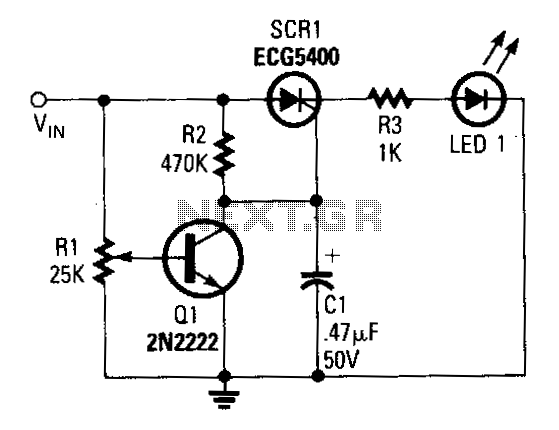
Low-voltage-indicator

The input terminal VIN is connected to the +V line of the circuit that the indicator is meant to monitor, and the grounds of both circuits are interconnected. The position of the potentiometer R1's wiper determines the base voltage of transistor Q1. As long as the transistor receives sufficient bias voltage to remain on, the low voltage at the collector will prevent the SCR from firing. As the battery voltage begins to decrease, the base voltage of the transistor will also decline. When Q1 turns off (as VIN drops), the collector voltage rises. This increase in voltage provides enough gate drive to activate the SCR, which in turn illuminates the LED. The LED can also be replaced with a buzzer or any other type of warning device.
The circuit described functions as a voltage monitoring system utilizing a transistor (Q1) and a silicon-controlled rectifier (SCR) to indicate when the voltage level drops below a predefined threshold. The input terminal VIN serves as the voltage reference point, linked directly to the monitored circuit's positive voltage line. The common ground connection ensures a stable reference point for both the monitoring circuit and the indicator.
The potentiometer R1 plays a crucial role in setting the bias voltage for the transistor Q1. By adjusting the wiper of R1, the user can fine-tune the base voltage applied to Q1, thus controlling its operation. When the battery voltage is adequate, Q1 remains in the 'on' state, allowing low voltage at its collector. This low collector voltage inhibits the SCR from conducting, preventing the LED (or alternative warning device) from activating.
As the battery voltage begins to decline, the base voltage of Q1 also decreases due to the voltage divider effect created by R1. Once the base voltage falls below a certain threshold, Q1 turns off, leading to a rise in the collector voltage. This increase is critical as it provides the necessary gate trigger for the SCR to turn on, resulting in the activation of the LED or other warning mechanisms.
The design allows for flexibility in the choice of the warning device. While the LED is commonly used for visual indication, a buzzer can be employed for audible alerts, enhancing the circuit's functionality in various applications. This monitoring circuit is particularly useful in battery-operated devices where maintaining a certain voltage level is essential for proper operation.Input terminal VIN is connected to the +V line of tbe circuit that the indicator is to monitor, and the grounds of botb circuits are connected togetber. The position of potentiometer Rl"s wiper determines Q1"s base voltage. As long as the transistor gets enough bias voltage to remain on, the low voltage at tbe collector will keep the SCR from firing.
As tbe battery voltage starts to fall, the transistor"s base voltage will fall as well. When Ql turns off (VIN drops), tbe collector voltage increases. That voltage provides enough gate drive to tum on the SCR, which turns on tbe LED. The LED could also be a buzzer or almost any otber type of warning device. 🔗 External reference
The circuit described functions as a voltage monitoring system utilizing a transistor (Q1) and a silicon-controlled rectifier (SCR) to indicate when the voltage level drops below a predefined threshold. The input terminal VIN serves as the voltage reference point, linked directly to the monitored circuit's positive voltage line. The common ground connection ensures a stable reference point for both the monitoring circuit and the indicator.
The potentiometer R1 plays a crucial role in setting the bias voltage for the transistor Q1. By adjusting the wiper of R1, the user can fine-tune the base voltage applied to Q1, thus controlling its operation. When the battery voltage is adequate, Q1 remains in the 'on' state, allowing low voltage at its collector. This low collector voltage inhibits the SCR from conducting, preventing the LED (or alternative warning device) from activating.
As the battery voltage begins to decline, the base voltage of Q1 also decreases due to the voltage divider effect created by R1. Once the base voltage falls below a certain threshold, Q1 turns off, leading to a rise in the collector voltage. This increase is critical as it provides the necessary gate trigger for the SCR to turn on, resulting in the activation of the LED or other warning mechanisms.
The design allows for flexibility in the choice of the warning device. While the LED is commonly used for visual indication, a buzzer can be employed for audible alerts, enhancing the circuit's functionality in various applications. This monitoring circuit is particularly useful in battery-operated devices where maintaining a certain voltage level is essential for proper operation.Input terminal VIN is connected to the +V line of tbe circuit that the indicator is to monitor, and the grounds of botb circuits are connected togetber. The position of potentiometer Rl"s wiper determines Q1"s base voltage. As long as the transistor gets enough bias voltage to remain on, the low voltage at tbe collector will keep the SCR from firing.
As tbe battery voltage starts to fall, the transistor"s base voltage will fall as well. When Ql turns off (VIN drops), tbe collector voltage increases. That voltage provides enough gate drive to tum on the SCR, which turns on tbe LED. The LED could also be a buzzer or almost any otber type of warning device. 🔗 External reference